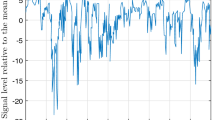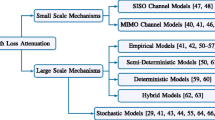Abstract
We discuss a statistical model to generate correlated shadow-fading patterns for wireless systems in the absence of detailed propagation and landscape information. The currently available autocorrelation models result in anomalous effects that depend on traffic density and mobility, as they propose independent random processes for each mobile. Our approach involves generating a pre-computed fading map with the right marginal distributions and spatial correlations, which avoids inconsistencies such as providing widely differing values for mobiles close to each other. The correlations are introduced via a Gaussian random field, which has a covariance structure that depends on a set of parameters which can be computed from local measurements. The model is efficiently implemented using standard linear-algebra methods. We conclude by describing a simulation experiment to study the effect of correlations on call dropping. The experiment reveals a strong relationship between call dropping and the correlation length of the fading pattern, and indicates circumstances under which dropping may be relatively high.
Similar content being viewed by others
References
S.C. Borst, S.A. Grandhi, C.L. Kahn, K. Kumaran, B.D. Lubachevsky and D. Sand, Wireless simulation and self-organizing spectrum management, Bell Labs Technical Journal 2(3) (Summer 1997) 81–98.
S.J. Fortune, D.M. Gay, B.W. Kernighan, O. Landron, R.A. Valenzuela and M.H. Wright, WISE design of indoor wireless systems: Practical computation and optimization, IEEE Computational Science and Engineering 2(1) (Spring 1995) 58–68.
M. Gudmundson, Analysis of hand-over algorithm, in: 41st IEEE Transactions on Veh. Tech. Conf. (1991) pp. 537–542.
M. Gudmundson, Correlation model for shadow fading in mobile radio systems, Electronics Letters 27(23) (November 1991) 2145–2146.
M. Hata, Empirical formula for propagation loss in land mobile radio services, IEEE Transactions on Vehicular Technology 29 (1980) 317-325.
K. Kumaran, D. Geiger and L. Gurvits, Illusory surfaces and visual organization, Network: Computation in Neural Systems 7(1) (February 1996) 33–60.
A. Rajkumar, B.F. Naylor, F. Feisullin and L. Rogers, Predicting RF coverage in large environments using ray-beam tracing and partitioning tree represented geometry, Wireless Networks 2(2) (June 1996) 143-154.
J. Glimm and A. Jaffe, Quantum Physics (New York, Springer-Verlag, 1987).
Author information
Authors and Affiliations
Rights and permissions
About this article
Cite this article
Kumaran, K., Golowich, S.E. & Borst, S. Correlated Shadow-Fading in Wireless Networks and its Effect on Call Dropping. Wireless Networks 8, 61–71 (2002). https://doi.org/10.1023/A:1012771509178
Issue Date:
DOI: https://doi.org/10.1023/A:1012771509178




